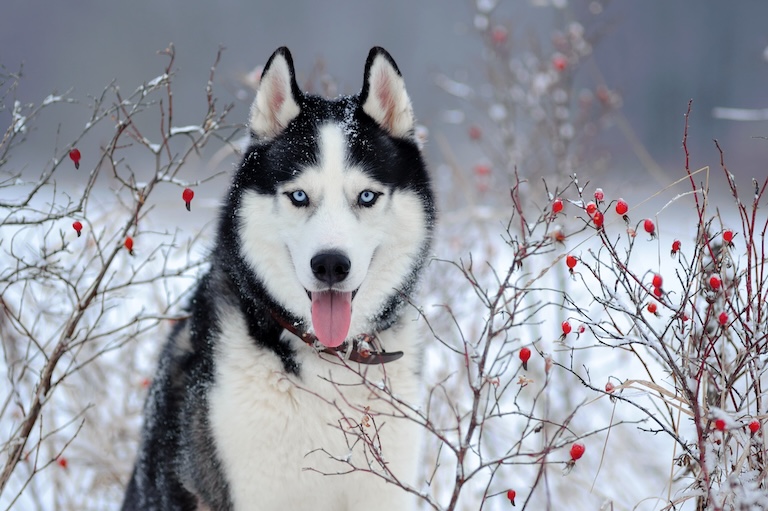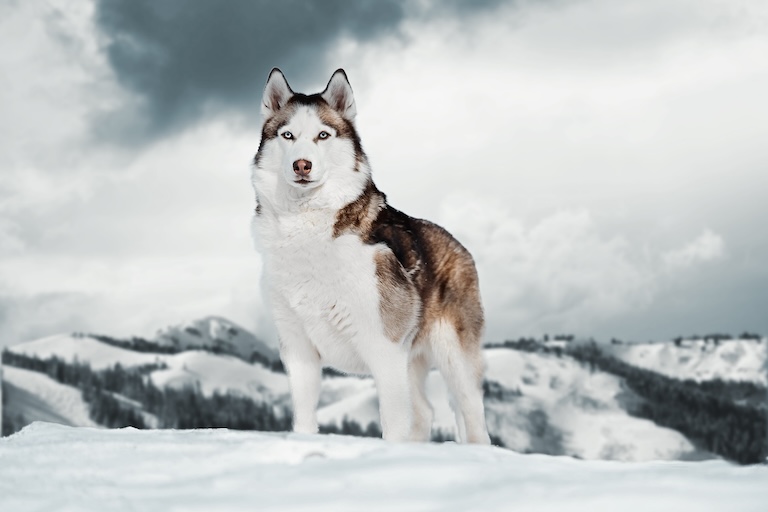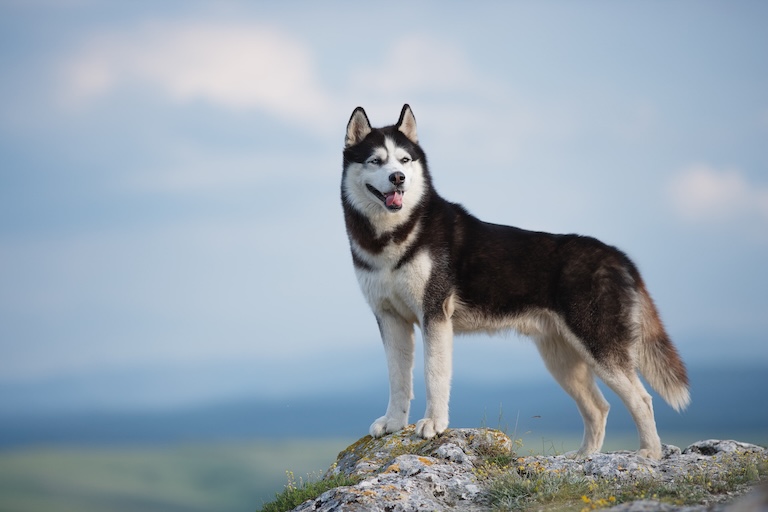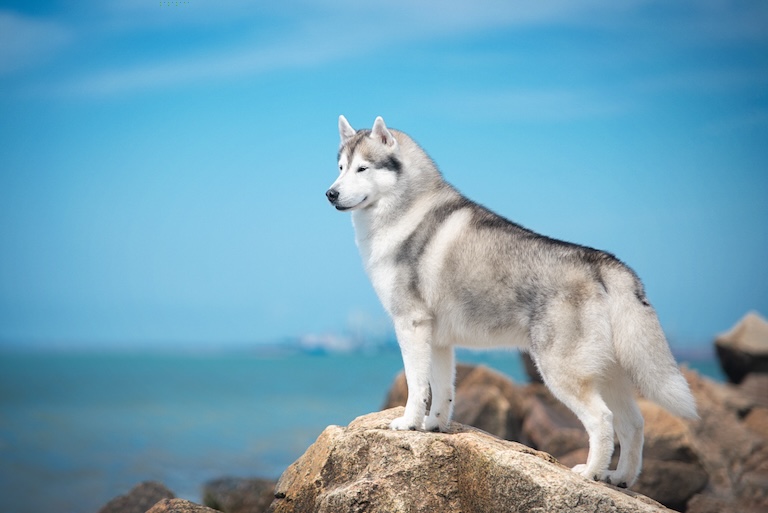Siberian Husky Profile
Animals built for running have a special kind of energy. Racehorses lined up at the gate twitch and buck, like the chugging of an idling muscle car, eager to release its power.
The equivalents in the dog world have to be the Arctic sledge pullers. These powerful, long-range animals share the same nervousness, but bring with it a level of smarts and playfulness you won’t find in horses or cars.
The Siberian husky might be the sharpest (not to mention the noisiest) of them all.

Siberian Husky Facts Overview
| Habitat: | Domestic, but bred for cols, frosty climates |
| Location: | Worldwide |
| Lifespan: | 14 years |
| Size: | Around 60cm (23.5 inches) tall |
| Weight: | Up to 32kg (70lb) |
| Colour: | Usually black and white, but can be varied |
| Diet: | Dog food |
| Predators: | None |
| Top Speed: | Around 23.7 mph (38.2 kmph) |
| No. of Species: | 1 |
| Conservation Status: | Not listed |
The Siberian husky is one of the most recognisable of dog breeds.
Sharp, icy blue eyes sit in front of a mischievous and loud personality, two of the many things that make these animals difficult to handle as pets.
But as working dogs, they are a formidable force. Able to cover vast Arctic plains in short amounts of time, and have worked their way into native cultures as both a colleague and a companion.
Interesting Siberian Husky Facts
1. They’re cold weather specialists
Believe it or not, Siberian Huskies were bred in Siberia, as working dogs for the native Chukchi people. They’re very closely related to the Alaskan malamute and Alaskan husky and have a whole bunch of wolf left in them.
It’s thought they descended from an extinct, cold-weather population of grey wolves, Canis lupus, that diverged from the main population before the dog/wolf split, so husky ancestors first became dogs, then bred back into a subpopulation of wolves to become the incredible beasts they are today.
Being fit for purpose in the Arctic means these dogs have thick, double coats. This coat can handle temperatures lower than -50°C in the winter and reflect the sun’s heat fairly well in the summer.
They also have snow-adapted eyes and frightening endurance.
2. They have exceptional endurance
As opposed to the larger and stronger Malamute, which was bred to pull heavy loads short distances, huskies are better at pulling lighter packs over longer distances.
They do this for long periods at impressive speed and can cover more than 160km in a day. This feat has made them well respected in Arctic communities, as they have long been used to bring valuable supplies to towns blocked in by snow.
And huskies love to run. They have enormous amounts of energy already, but, just like people, they can benefit and improve significantly if given the right kind of exercise.

3. They benefit from HIIT
Like humans, dogs can become big fat fatties if they eat junk and don’t exercise. Most breeds aren’t designed to pull things or do any work at all, so for them, a little exercise goes a long way. But for huskies, who can already run up to 50km in their unfit state, HIIT can be used to help them reach their incredible peak.
Research is underway to identify the best high-intensity interval training (HIIT) protocol for working huskies.
If you haven’t heard of HIIT, it’s a form of cardio that essentially brings you to (and sometimes across) the verge of vomiting multiple times, with short breaks in between, for a total of 10-20 minutes. It’s a real-life life-hack for those who can endure the pain, and rapidly boosts both metabolism and anaerobic fitness without the need for long periods of exercise.
The dogs in these studies aren’t pushed quite as hard, but already there’s evidence that HIIT improves fitness in working dogs significantly, and might be an efficient way to keep working huskies in good shape.
For pets, this probably isn’t necessary, but the breed is notorious for being high maintenance, regardless. 1
4. They’re really smart
Alongside their insatiable appetite for running, huskies are known to be hard to entertain. High intelligence has high stimulatory requirements, and this can make them a handful for pet owners and sledge drivers alike.
They’re also very independent and can be stubborn, leading inexperienced owners to condemn many individuals as “untrainable”. Still, with the right experience and work ethic, this intelligence makes huskies a dream to work with for trainers, and they can be a very rewarding companions with huge amounts of character and individuality when treated right.

5. They are good at escaping
When under-stimulated, however, they can be hell to deal with. Huskies in general are notorious escape artists, and their problem-solving, coupled with their high energy levels can make them hard to contain.
Huskies have a drive to explore and to run, and if this experience isn’t granted them, they will literally climb walls to make it happen themselves.
But even a well-contained husky can be hard work.
6. They’re vocal
Huskies have a voice, and they’re not afraid to use it. They’ll sing at the slightest provocation, they’ll yell, argue, complain and express themselves in a number of different ways, always with a disregard for volume.
This can be adorable (and don’t they know it), hilarious, and even useful in terms of understanding what the animal needs, but rarely is it as appreciated by the neighbours.
As for dealing with their owners, huskies will always win an argument, often simply by way of the Trumpian approach: being louder and more obnoxious than you can. 2
7. They can overeat
These dogs might be considered “high-quality stock”, as are many of the true working breeds. Animals bred to interact with humans tend to have higher fitness and intelligence than those bred as pets or as tools for sniffing or killing things.
As such, it’s typically recommended that their fuel is of higher quality, especially if they’re being put to work. Huskies often benefit from regular feeding times and will be prone to over-eating if left to free-feed. 3
8. They have few health issues
For a purebred dog, huskies have relatively few common ailments. Still, there is a handful of stuff that shows up fairly often; a product of their white weather adaptations and the limited genetic pool that pure breeds necessarily draw from.
Huskies have very pale eyes. This is an apparent side effect from the particular expression of a gene responsible for skull and facial development in dogs and stems from a lack of pigment in the iris.
While this is a striking characteristic, it brings with it certain predispositions, like the susceptibility of huskies to retinal atrophy, corneal dystrophy, and other eye issues associated with the breed.
They’re also prone to hypothyroidism, which can contribute to weight gain, and hip dysplasia, another very common ailment for large pedigrees.
But these issues seldom appear, relative to many other breeds, and huskies are consequently one of the healthier options for purebreds. Still, with its high energy levels and requirements for stimulation and socialisation, it’s not a beginner breed at all. 4 5

Siberian Husky Fact-File Summary
Scientific Classification
| Kingdom: | Animalia |
| Phylum: | Chordata |
| Class: | Mammalia |
| Order: | Carnivora |
| Family: | Canidae |
| Genus: | Canis |
| Species: | Lupus |
| Subspecies: | Familiaris |
Fact Sources & References
- Sonia C. Orozco (2021), “Efficacy of high-intensity interval training compared with moderate-intensity continuous training on maximal aerobic potency in dogs: Trial protocol for a randomised controlled clinical study”, Vet Record Open.
- The Pet Collective (2017), “Funniest Husky Videos”, YouTube.
- “Siberian Husky”, husse.
- Yuliya Markitantova (2020), “Inherited Eye Diseases with Retinal Manifestations through the Eyes of Homeobox Genes”, PubMed Central.
- KITSON JAZYNKA (2018), “Why Siberian huskies have those brilliant baby blues”, National Geographic.
